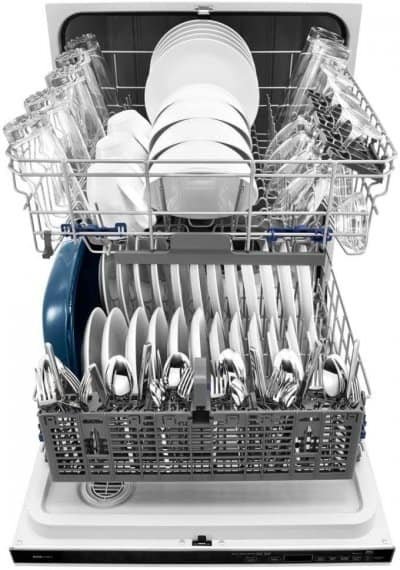Dishwashers have become an essential appliance in many homes, making it easier and more efficient to clean dishes. However, many people are often concerned about the amount of water and electricity a dishwasher uses. In this article, we will explore how much water and electricity a dishwasher typically uses, and what factors can affect these usage levels.
Table of Contents
Water Usage
When it comes to water usage, dishwashers generally use less water than washing dishes by hand. However, the amount of water used by a dishwasher can vary depending on several factors, including the type of dishwasher, the size of the load, and the wash cycle selected.
According to the Environmental Protection Agency (EPA), a standard dishwasher uses around 3.5 to 6 gallons of water per cycle. Energy Star-certified dishwashers, which are designed to be more energy-efficient, use even less water, typically around 3.1 gallons per cycle.
The amount of water used by a dishwasher can also vary depending on the wash cycle selected. For example, a dishwasher’s normal cycle will use more water than a light cycle. The heavy cycle may use more water than the normal cycle because it requires more water to wash off tougher stains and food particles.
Additionally, the size of the dishwasher load can affect water usage. Dishwashers are designed to accommodate different load sizes, so it’s essential to choose the right load size for the dishes you need to clean. Overloading a dishwasher can lead to less efficient water usage and can also affect the quality of the cleaning.
Another factor that can impact the amount of water a dishwasher uses is pre-rinsing. Some people prefer to pre-rinse their dishes before placing them in the dishwasher, which can use additional water. However, many modern dishwashers are designed to handle dishes without pre-rinsing, making it unnecessary to use extra water in this way.
Overall, while the amount of water used by a dishwasher can vary depending on several factors, modern dishwashers are designed to be water-efficient and use significantly less water than washing dishes by hand.
Electricity Usage
The amount of electricity used by a dishwasher is another concern for many people. However, like water usage, the amount of electricity a dishwasher uses can vary depending on several factors.
According to Energy Star, a typical dishwasher uses around 0.87 kWh of electricity per cycle. This equates to an average annual energy use of 270 kWh, costing around $32 per year on average.
However, some factors can impact the amount of electricity a dishwasher uses. One of the most significant factors is the age of the dishwasher. Older models may use more electricity than newer, more energy-efficient models. In general, Energy Star-certified dishwashers use less electricity than non-certified models.
Another factor that can impact electricity usage is the dishwasher’s settings. Using more energy-intensive settings, such as a heated dry cycle, can increase the amount of electricity used. Choosing a low-temperature wash or air-dry cycle can help reduce electricity usage.
Additionally, the size of the dishwasher load can affect electricity usage. Overloading a dishwasher can lead to less efficient electricity usage and can also affect the quality of the cleaning. It’s essential to choose the right load size for the dishes you need to clean.

Tips to Reduce Water and Electricity Usage
While modern dishwashers are designed to be water and energy-efficient, there are still steps you can take to reduce their usage further. Here are some tips to help you use your dishwasher more efficiently:
While modern dishwashers are designed to be water and energy-efficient, there are still steps you can take to reduce their usage further. Here are some tips to help you use your dishwasher more efficiently:
- Wait until the dishwasher is full before running it. Running a half-empty dishwasher wastes water and electricity.
- Use the appropriate load size setting for the dishes you need to clean. Overloading a dishwasher can lead to less efficient water and electricity usage.
- Choose the most water and energy-efficient cycle for the dishes you need to clean. For example, if you’re only washing lightly soiled dishes, use a light cycle instead of a heavy cycle.
- Use the delay start feature to run your dishwasher during off-peak hours. Many dishwashers come with a delay start feature, allowing you to set the dishwasher to run during off-peak hours when electricity rates are lower.
- Avoid pre-rinsing your dishes. Modern dishwashers are designed to handle dishes without pre-rinsing, which can save water and time.
- Use the air-dry setting instead of the heated-dry setting. The air-dry setting uses less electricity than the heated dry setting, which can help reduce your dishwasher’s energy usage.
- Regularly clean and maintain your dishwasher. A dirty dishwasher can affect its efficiency and increase its water and electricity usage. Clean the dishwasher’s filter and spray arm regularly, and use a dishwasher cleaner to keep your dishwasher running efficiently.
Conclusion
Overall, modern dishwashers are designed to be water and energy-efficient, using significantly less water and electricity than washing dishes by hand. The amount of water and electricity a dishwasher uses can vary depending on several factors, including the type of dishwasher, the size of the load, and the wash cycle selected. However, there are steps you can take to reduce your dishwasher’s water and electricity usage further, such as waiting until the dishwasher is full before running it, choosing the appropriate load size setting, and using the air-dry setting instead of the heated dry setting. By following these tips, you can save water and electricity while still keeping your dishes clean and sanitary.

